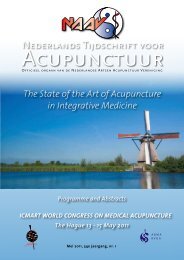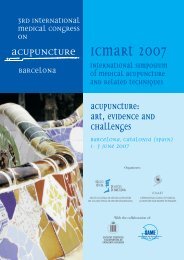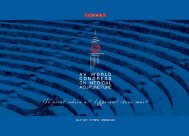Congress Abstracts full PDF - International Council of Medical ...
Congress Abstracts full PDF - International Council of Medical ...
Congress Abstracts full PDF - International Council of Medical ...
Create successful ePaper yourself
Turn your PDF publications into a flip-book with our unique Google optimized e-Paper software.
331 case subjects from 3 university hospitals were met the inclusion criteria. And the same <strong>of</strong> healthy control group<br />
extracted by a simple random selection using PROC SURVEYSELECT with consideration <strong>of</strong> age and gender. The<br />
patient group's data was attained by preparing a case report form based on standard operating procedures, aimed<br />
to survey patients with informed consent, who volunteered to participate in the study for researching the risk factors<br />
<strong>of</strong> cerebro-vascular disease. The total number <strong>of</strong> subject was 662(case group 331, control group 331). And the<br />
statistical analysis method is as following first, comparing the technical statistics quantity on risk factor <strong>of</strong> stroke<br />
among analysis object people and conducting Chi-square test or Fisher's exact test on the quality variable for the<br />
univariate analysis, and conducting independent t-test for the quantity variable and after that, conducting logistic<br />
regression analysis in order to get the odds ratio and finally building suitable model by using the Hosmer and<br />
Lemeshow's goodness <strong>of</strong> fit test. Moreover, the interaction effects between Sasang constitution and stroke risk factor<br />
was confirmed. And using the CART algorithm, the best decision tree model <strong>of</strong> stroke events was established. In a<br />
condition that age and gender were controled by logistic regression, the relative risk <strong>of</strong> stroke attack by Sasang<br />
constitution classification was obtained Soyangin's risk ratio was 1.75 times higher than Taeumin's, and it was<br />
statistically significant(OR=1.75, 95% CI 1.23-2.49). However, consideration <strong>of</strong> body mass index(BMI), waist<br />
circumference, past history <strong>of</strong> hypertension and diabetes, history <strong>of</strong> drinking and smoking makes even better model.<br />
According to that model, Soyangin's risk ratio <strong>of</strong> stroke goes up 6.34 times higher than Taeumin's(OR=6.34, 95% CI<br />
3.08-13.04 Hosmer & Lemeshow goodness <strong>of</strong> fit test, X2 P-value=0.89). According to CART algolithm, the most<br />
overriding variable was the history <strong>of</strong> risk factor <strong>of</strong> cardiovascular disease. Among the group without past history, they<br />
were divided the most it they were Soyangin or not. The next overriding variable was drinking history among Soeumin<br />
and Tarumin. Among Soyangin, the next overriding variable was exercise regularly. The misclassification rate <strong>of</strong><br />
CART algolithm was 0.274 though. This study suggests that the risk <strong>of</strong> stroke is different significantly according to<br />
Sasang constitution. And the risk <strong>of</strong> stroke increase with the interaction effects between the Sasang constitution and<br />
the other risk factors such as hypertension, waist circumference, diabetes, obesity and smoking. Moreover this study<br />
supports that it is possible to make an accurate estimate model <strong>of</strong> a stroke attack with Sasang constitution in the near<br />
future.<br />
EFFECTIVENESS OF KOREAN ACUPUNCTURE TREATMENT IN HYPERTENSION PATIENTS: CONTROLED<br />
CLINICAL TRIAL<br />
C. Han, M. Shin, G. Kim, S. Park, S. Choi<br />
Department <strong>of</strong> <strong>Medical</strong> Research, Korea Institute <strong>of</strong> Oriental Medicine, Korea<br />
Objective: Aim <strong>of</strong> this study was to investigate the antihypertensive effect <strong>of</strong> Acupuncture in hypertensive patients.<br />
Materials and methods We measured the blood pressure <strong>of</strong> 30 patients who were admitted in the Oriental <strong>Medical</strong><br />
Clinic <strong>of</strong> Chaseo from 13th February 2007 to 13th May 2007. We included the patients only in case <strong>of</strong> the systolic<br />
blood pressure was over 120mmHg or diastolic blood pressure was over 80mmHg. The patients were treated by an<br />
acupuncture treatment (Gyeok-pal sang-saeng-Yeok-chim GPSSYC). To evaluate the effect <strong>of</strong> the GPSSYC, the<br />
blood pressure and pulse rate were measured before and after acupuncture treatment for total <strong>of</strong> 10 times. Collected<br />
data were analyzed by paired t-test, repeated measure ANOVA.<br />
Results: After 3 weeks, there were significant decrease in the systolic blood pressure (P







